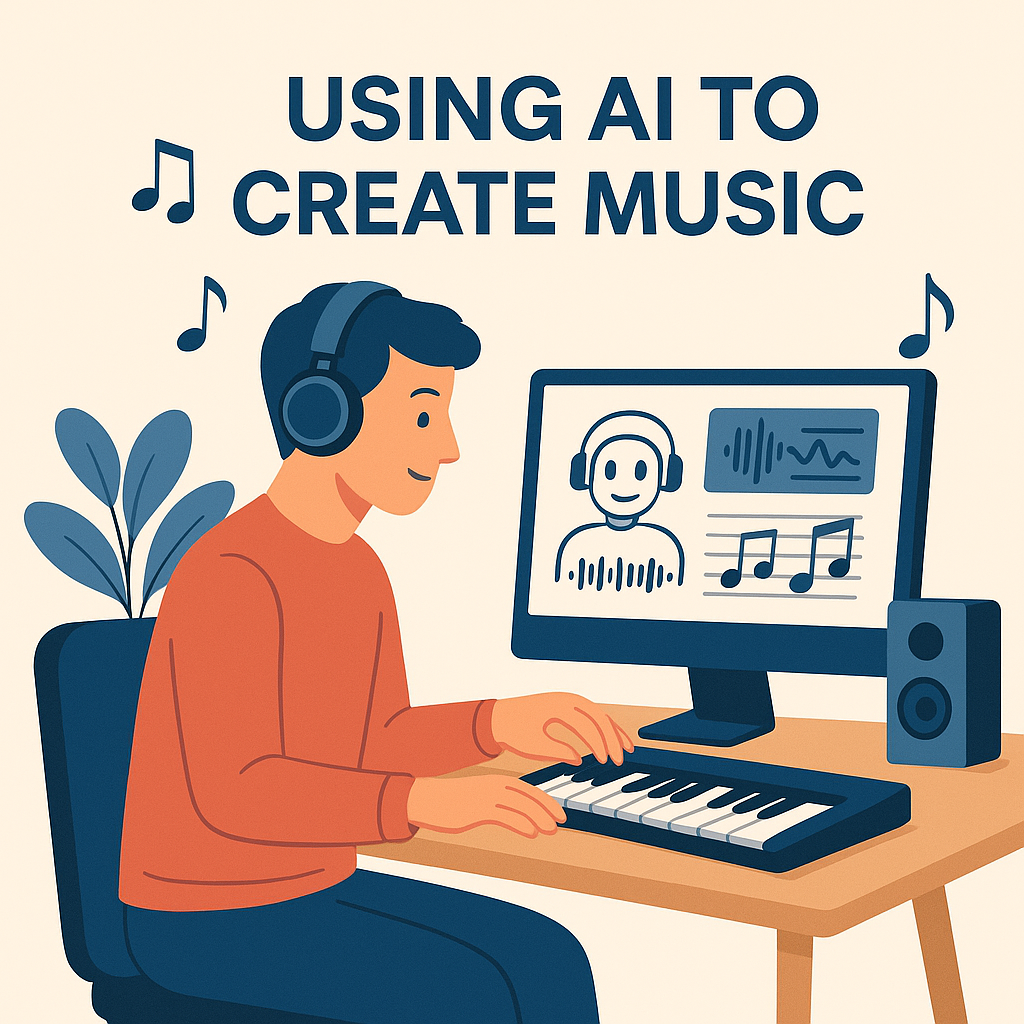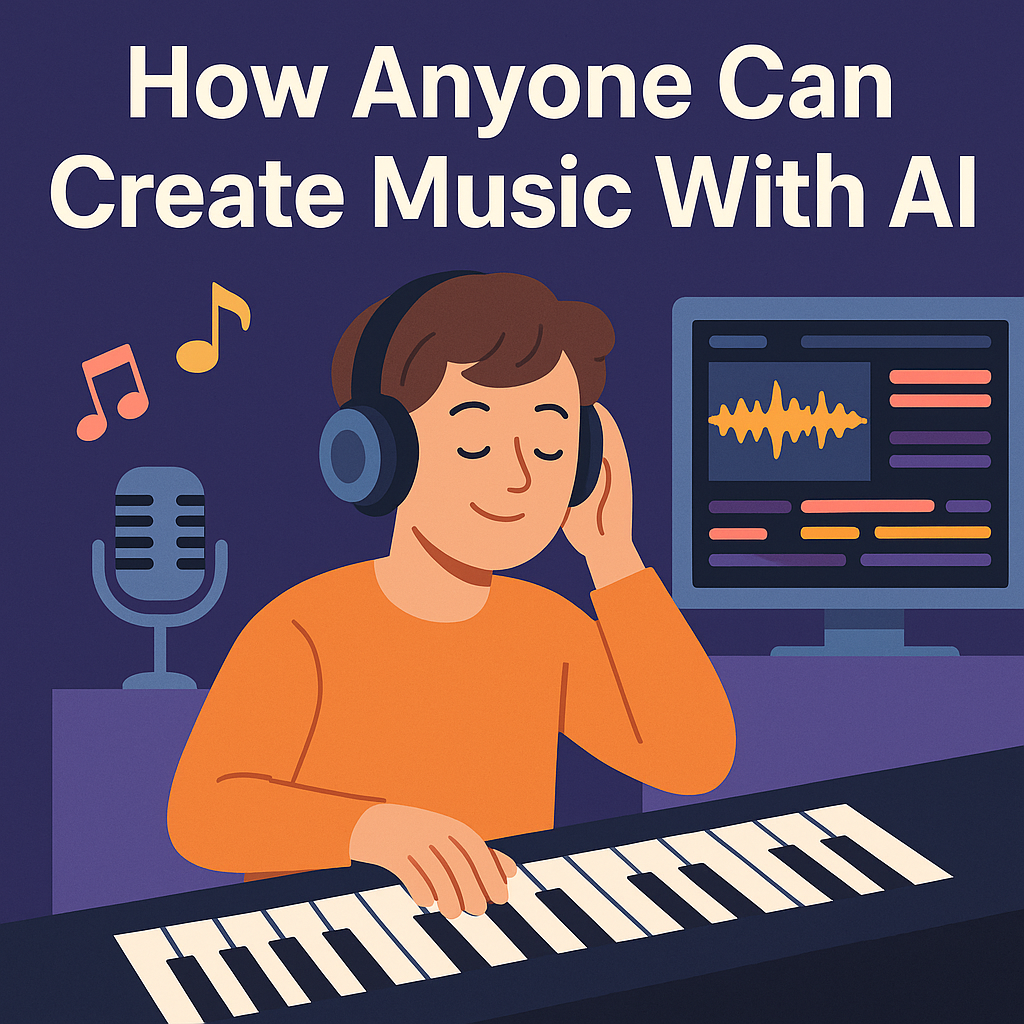Ever wished you could create your own music… but felt totally lost because you don’t play an instrument or know music theory? You’re not alone.
The good news is that AI music tools now make it possible for anyone to create songs, beats, and background tracks using plain language. If you can describe how you want something to sound, you can start making music with AI.
In this friendly guide from AIBeginner.net, we’ll walk through how AI music generators work, how to write good prompts, and simple ways to use AI-generated music in your projects — without feeling overwhelmed or “too technical.”
What Does It Mean to “Use AI to Create Music”?
AI music tools are like smart, flexible collaborators. Instead of sitting at a piano or learning a DAW (digital audio workstation), you:
- Tell the AI what you want: mood, genre, energy, instruments.
- Optionally give it lyrics or a short idea.
- Let the AI generate a track for you in seconds.
The result might be:
- Background music for YouTube videos or tutorials.
- A fun intro for your podcast.
- Study or focus music for your own use.
- A personal “theme song” for your brand or side project.
You’re still the creative director — AI just handles the heavy lifting.

Why AI Music Is Perfect for Absolute Beginners
At AIBeginner.net, we focus on people who are brand-new to AI. When it comes to music, here’s why AI is such a perfect starting point:
- No instruments required: You don’t need a guitar, piano, or studio.
- No music theory needed: AI understands chords, tempo, and harmony for you.
- No complicated software: Most AI music tools run in your browser with simple buttons.
- Instant feedback: You can try an idea, listen, adjust, and regenerate in minutes.
If you’ve ever thought “I’m just not musical,” AI is a gentle way to prove that wrong and have fun in the process.
Step-by-Step: Create Your First AI-Generated Track
You’ll see different buttons and layouts depending on which AI music tool you use, but the basic flow is similar across most platforms.
Step 1: Choose the purpose of your music
Ask yourself: “Where will I use this?” Some common use cases:
- Calm background music for a YouTube tutorial.
- Energetic intro for a podcast or livestream.
- Soft instrumental music for meditation or focus.
- A fun song to share with friends or your community.
Knowing the purpose helps you describe the mood and energy level clearly.
Step 2: Pick a style (genre)
Next, think about the style or genre. You don’t need precise labels — simple descriptions work:
- Lofi beats
- Soft piano
- Acoustic guitar
- Epic cinematic orchestra
- Chill electronic
- Upbeat pop
Combine this with the purpose — for example: “chill lofi beat for studying” or “epic orchestral track for a dramatic intro.”
Step 3: Describe the sound in plain language
Now you’ll usually see a text box where you can describe what you want. This is your prompt. Here’s a simple formula you can use:
Mood + Genre + Instruments + Tempo + Purpose
Examples:
- “Calm lofi hip hop beat with soft piano and gentle drums, slow tempo, for relaxing and reading.”
- “Bright, upbeat pop track with guitar and synths, medium tempo, perfect for YouTube intros.”
- “Cinematic orchestral track with strings and drums that builds slowly and feels inspiring.”
- “Soft piano and ambient pads, slow and peaceful, background music for meditation.”
Don’t worry about being perfect. If the first result isn’t right, tweak a few words and generate again.
Step 4: Listen, tweak, and regenerate
Once your track is generated, listen with a beginner’s mindset:
- Is the energy too high or too low?
- Do you like the instruments being used?
- Does it fit the mood you had in mind?
If not, adjust your prompt. Add words like “slower,” “simpler,” “more acoustic,” “no vocals,” or “only drums and bass,” then generate again.
Step 5: Download and use your track
When you’re happy with a track, you can download it (usually as an MP3 or WAV). Then you can add it to:
- Video editors like Clipchamp, CapCut, or Premiere.
- Podcast editing tools.
- Presentation slides.
- Your personal “focus music” playlist.
Always double-check the usage rights and license in the AI tool you’re using, especially if you plan to use the track in public or commercial projects.
Prompt Ideas You Can Copy and Paste
Here are some ready-made prompt ideas to help you get started faster. You can paste these into most AI music generators and then customize them:
- For YouTube tutorials:
“Warm, friendly background music with gentle guitars and light percussion, medium tempo, loopable, not distracting, perfect for educational YouTube tutorials.” - For podcasts:
“Short, upbeat intro music with drums and synths, energetic but not too intense, ideal for podcast intro and outro segments.” - For studying or focus:
“Slow, relaxing lofi beat with soft piano and vinyl crackle, no vocals, perfect for deep focus and studying.” - For business content:
“Modern, confident corporate background music with muted guitars and subtle synths, medium tempo, suitable for business presentations and explainer videos.” - For fun and personal projects:
“Happy, playful pop track with ukulele and claps, cheerful and light-hearted, great for family videos and social media clips.”
How Creators Are Using AI Music Today
Creators, small business owners, and hobbyists are using AI-generated music in all sorts of ways:
- Solo creators: Add background music to screen recordings, tutorials, and social posts.
- Small businesses: Create simple brand themes or explainer video soundtracks without hiring a composer.
- Teachers and trainers: Use calm, instrumental tracks in courses and lessons to keep learners engaged.
- Podcasters: Generate unique intro and outro themes instead of using generic stock tracks.
If you’re learning AI through the AI Beginner Academy, AI music is a great “side project” to explore creativity while you build practical skills in prompts, tools, and automation.
Important: Licensing, Credits, and Good Habits
Before you publish anything with AI-generated music, keep these guidelines in mind:
- Check the terms of use: Some tools allow commercial use on free plans, others require a paid plan.
- Keep track of which tool you used: Note the platform and track name or project so you can reference it later if needed.
- Consider giving credit: Even if not required, you can optionally mention that the music was “Created with an AI music tool” in your description.
- Stay transparent with your audience: If you talk about your process, sharing that you used AI can actually build trust and spark curiosity.
At AIBeginner.net and inside AI Beginner Academy, we always encourage a “human first, tools second” mindset: you stay in control, and AI just helps you do more of what you love.
Quick FAQ: Using AI to Create Music
Do I need to be “techy” to use AI music tools?
No. If you can type a short sentence like “calm piano music for studying,” you’re ready. Many AI platforms are designed so non-technical users can start in minutes.
Will AI music replace human musicians?
AI is great at generating ideas, backgrounds, and quick drafts — but it doesn’t replace human emotion, performance, or collaboration. Many musicians already use AI as a sketchpad or idea generator, not as a replacement for their craft.
Can I learn more about AI beyond music?
Absolutely. If you enjoy this kind of creative experiment, you’ll probably love exploring AI for writing, images, automation, and everyday productivity. That’s exactly what we teach step by step inside the AI Beginner Academy.
Where to Go Next
If this is your first time playing with AI music, treat it like a creative playground. Try a few prompts, listen, tweak, and have fun. You’ll be surprised how quickly you can build a small library of tracks tailored to your style.
And if you want a friendly, guided path to learning AI from the ground up — not just for music, but for writing, automation, and everyday work — take a look at the beginner-friendly courses inside the AI Beginner Academy. Everything is designed for absolute beginners, with simple language, real examples, and practical workflows.
You don’t have to become a professional musician or AI expert to get value from these tools. Start small, stay curious, and let AI help you bring more of your ideas to life.
